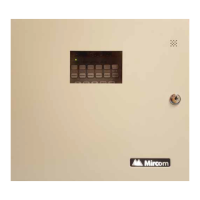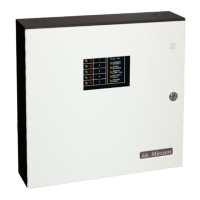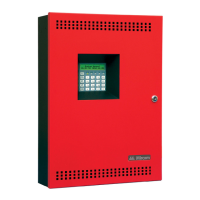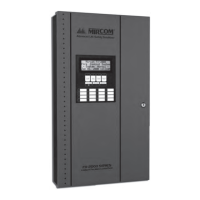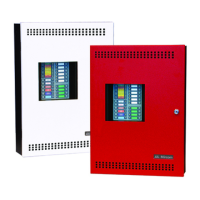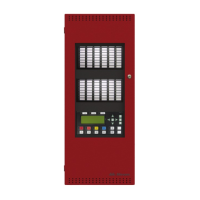53
Indicators, Controls, and Operation
8.2.8 Alm/Sup/Tbl/Bldg Audible Sil Button (Blue)
Activation of the Alm/Sup/Tbl/Bldg Audible Sil button while the buzzer is sounding silences the
buzzer. The buzzer will resound if there is a subsequent event. Pressing the button when the
buzzer is not sounding has no effect.
8.3 Circuit Status Indicators
There is one pair of circuit Status LEDs for each initiating, indicating, and relay circuit. The first
four indicating circuits on the main fire alarm module are part of the common indicators. All
other circuits (including the first eight initiating circuits on the main fire alarm module) are
arranged in columns of eight indicators numbered from one to eight. For each circuit, the
upper circuit Status LED may be red or amber, and will either be steadily illuminated or
flashing at either the fast flash or trouble flash rates, depending on the operation. The amber
Circuit Trouble LED flashes at the trouble flash rate when active. The Status LED is used on
initiating circuits only.
After the first eight initiating circuits (corresponding to the first column of circuit LED's) the
circuit LEDs are configured in the same order as any adder modules. If there are insufficient
display adders for the number of circuits on the panel, the last circuits will not be displayed. If
there are too many displays for the number of circuits on the panel, the unassigned ones will
be unused.
8.3.1 Alarm Circuit Indicators
The operation of alarm circuit indicators applies to initiating circuits configured as verified
alarm, non-verified alarm, water-flow alarm, sprinkler alarm, or general alarm circuits.
• The Circuit Trouble LED flashes at the trouble flash rate to indicate circuit trouble
(open circuit or Style D / Class A trouble) or a disconnected circuit. It always turns off
when the circuit is in alarm.
• The Circuit Status LED illuminates steady red when the circuit is in alarm. On verified
alarm circuits, sprinkler alarm, and water-flow alarm circuits, the circuit Status LED will
illuminate at the fast flash rate during the pre-alarm condition. This LED will also flash at
the fast flash rate while an active circuit is being un-disconnected.
8.3.2 Supervisory Circuit Indicators
The operation of supervisory circuit indicators applies to initiating circuits configured as
latching or non-latching supervisory circuits.
• The Circuit Trouble LED flashes at the trouble flash rate to indicate circuit trouble (open
circuit or Class A (Style D) trouble) or a disconnected circuit. It always turns off when the
circuit is in alarm.
• The Circuit Status LED turns on steady amber when the corresponding circuit is in
alarm. This LED will also flash at the fast flash rate while an active circuit is being
reconnected.
8.3.3 Property and Building Safety Circuit Indicators
The operation of Property and Building Safety (Monitor) circuit indicators applies to initiating
circuits associated with property and building safety.
• The Circuit Trouble LED flashes at the trouble flash rate to indicate circuit trouble (open
circuit or Class A (Style D) trouble) or a disconnected circuit. It always turns off when the
circuit is in alarm.
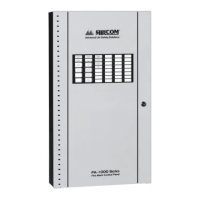
